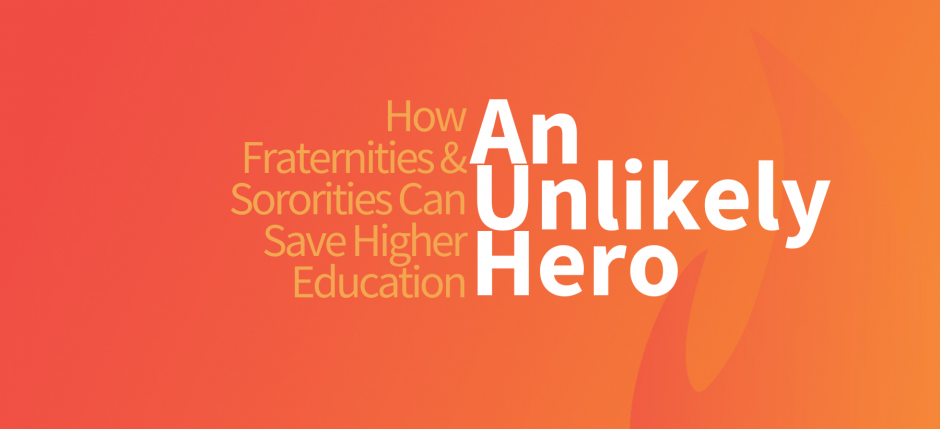An Unlikely Hero: How Fraternities & Sororities Can Save Higher Education
by Josh Orendi
“Put us to work! We’re ready.” Aaron Varnue, said on a call last week. He’s a junior business major and chapter president of Acacia Fraternity at Purdue University. Aaron’s chapter isn’t alone. Fraternities and sororities are ready right now to help their schools with student enrollment and retention.
Colleges across the country fear that enrolled students won’t show up on campus this fall. This is the COVID-19 effect. Over 40% of parents report that they are either uncertain or would not send their child to school for the fall semester in a remote-learning environment, according to an April 10-14 survey conducted by Tyton Partners.
Meanwhile, a survey by OneClass reports that 75% of college students moved to virtual classrooms don’t think they’re receiving a quality learning experience. Students are not getting the experience they paid tens of thousands of dollars to receive. That has a lot of people asking if they will all come back in fall 2020.
Now add in skyrocketing costs of higher education, on campus safety risks, a lot of uncertainty, and the fact that college enrollment has declined every year for 8 years in a row. That could be a recipe for an admissions disaster this fall. Colleges could lose 20% of students this fall according to Inside Higher Education.
Could an unlikely hero emerge?
Enter fraternities and sororities. “We are social organizations. This is what we do. Our organizations exist to provide peer-to-peer support and mentorship. To create deep connections and belonging. Brotherhood. Sisterhood. To serve our communities and alma mater. We see the enrollment and retention problem. It’s our problem, too. We want to help!” the Purdue junior continued.
He’s not alone.
Approximately 900,000 undergraduates and about 9,000,0000 living alumni are members of fraternities and sororities on over 800 campuses in the United States. (For a size perspective, that’s more people than the total population of New Jersey) Or roughly 10% to 15% of students on the average college campus. Mobilizing social fraternal organizations is a powerful idea that should be taken seriously.
Fraternity and sorority membership contributes to a students’ sense of community and belonging on campus, which provides a greater sense of attachment to a university. Research shows that much of the stress of first-year students stems from loneliness. Fraternities and sororities provide connection, friendship and a strong support system.
Gallup research found that fraternity and sorority members possess a stronger sense of well being, are more likely to receive emotional support as an undergraduate, and demonstrate more alumni attachment to their alma mater than non-Greek students. One study found first-to-second year retention rates among sorority members at 93%, compared to 82% for non-members. Similar studies show fraternity members are 20% more likely to graduate.
Simply put, fraternity and sorority is good for enrollment, retention, community building, and student success. Fraternity and sorority members want to engage with each other and non-Greek students — especially incoming freshmen and transfer students.
Let me share a story.
Last week, my daughter fell off her bike. I raced inside to the medicine cabinet. Panicked. I knocked over every box and bottle looking for bandages. URG!!! Where are they!?? My wife walked up behind me, calmly reached over my shoulder, and pulled a box of Band-Aids from the shelf in front of me that had been there all along. Doh! “I love you. I got this,” she said to me.
Fraternities and sororities are the Band-Aids. Not a fix for everything, of course, but a fix that will make incoming students feel better right now. An authentic, scalable, peer-to-peer solution is literally sitting on the shelf of hundreds of colleges, but school administrators may be looking right past the Band-Aids during this moment of panic (which I totally understand).
Being overlooked isn’t new. Fraternities and sororities have been shunned, demonized, and underfunded on many campuses. (Overlooked sounds nicer) What many don’t realize is that membership numbers are at all time highs for most fraternities and sororities. Read that again. Student demand for the experience is at record highs.
Why? How? That’s not what the media is reporting. Well…
Fraternity and sorority members are campus leaders not raging alcoholics as the movies might lead you to believe. They lead their communities in service hours, academic achievement, and philanthropy dollars raised. They aren’t sex-obsessed, entitiled hazers as popular media outlets often describe them. They’re diverse, often first-gen students, who are eager to make connections, find leadership opportunities, and create friendships for a lifetime. In my experience, fraternal organizations demonstrate more loyalty to their alma mater than any other group of students.
Oh, and these students are exceptional at leveraging social/digital media to build and maintain relationships. They’re innovative and wildly creative. They’re problem solvers!
So imagine if those students wanted to mobilize and help during this crisis! Spoiler alert. They do. And at least one school has been smart enough to take them up on the offer.
On a conference call this month with a National Fraternity I heard a powerful story from Dr. Charlotte Emerson, Director of Student Development and Recruitment for the University of Florida’s College Of Agricultural and Life Sciences (CALS). “We are concerned many students will choose to stay closer to home as a result of COVID-19, as a college we wanted to be certain admitted students felt connected, wanted, and feel the pride we have for the University of Florida. We solicited the help of fraternity, sorority and other campus leaders to personally contact over 2000 admitted CALS students.” Specifically the college used peer-to-peer phone calls and text messages to communicate with admitted students using a script initially, and ending the call or text with an offer to answer questions and connect the student to a CALS academic advisor on campus.
Remember, many of the incoming freshmen are completing a senior year of high school that was ripped away from them. No prom. No spring sports. No spring break. No walk across the stage. No graduation party. No senior night. No good-bye hugs or yearbook signatures from friends. No closure. Instead, they’ve had months of quarantining with their parents and piecemealed e-learning.
Put yourself in their shoes.
Imagine getting a personal phone call to ask, “how are you?” A sophomore, junior, or senior FaceTiming you to say that they’re excited to meet you and welcome you to campus. A DM saying everything is going to be ok. A sincere message of reassurance, optimism, and someone you can call if you have questions. That’s what caring in a time of crisis looks like. That’s community.
That’s fraternity done right.
But, that example is more the exception than the norm right now. Chapters and campus Councils say they’re being met with resistance, ignored, or unable to get through the red tape of the school. A senior from a Missouri state school sounded exasperated when he told me, “We’ve offered to help and asked to team up with the school a bunch of times. We asked to partner with Orientation and Res Life. We fundraised with the alumni to offer scholarships to help incoming students, but we can’t even get the school to help us with a list of incoming students to give the money away. We’re trying! I swear. But, so far, we’ve been ignored or told no. I don’t get it.”
Certainly every school is unique. And, every fraternity and sorority community is unique. And relationships can be complex. What is not unique is that fall enrollment is a priority concern for every school, every fraternity, and every sorority. What is not complex is that we all need to chip in and work together.
I hope this article reaches every college President, Dean of Students, Office of Admissions, Orientation Department, Res Life program, and First Year Experience team. I hope it sparks a conversation about engaging fraternity and sorority now.
Put fraternity and sorority members to work. They are on your team. Use their skills. All they need is permission and a little guidance. Encourage them. Help them to reach out to incoming students. Then, step aside and watch them shine.
Think of me as your caring partner, reaching over your shoulder in a time of panic, showing you the Band-Aid box that’s been right in front of you all along. “I love you. You got this.”

